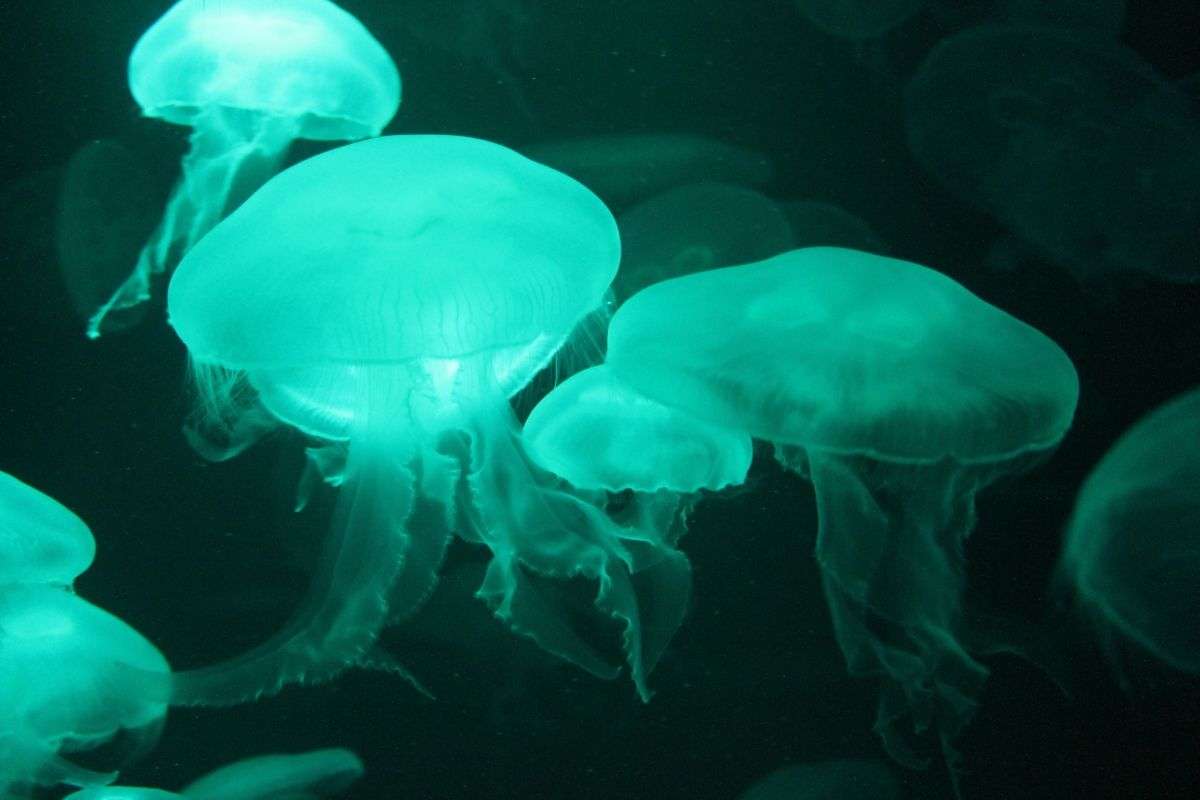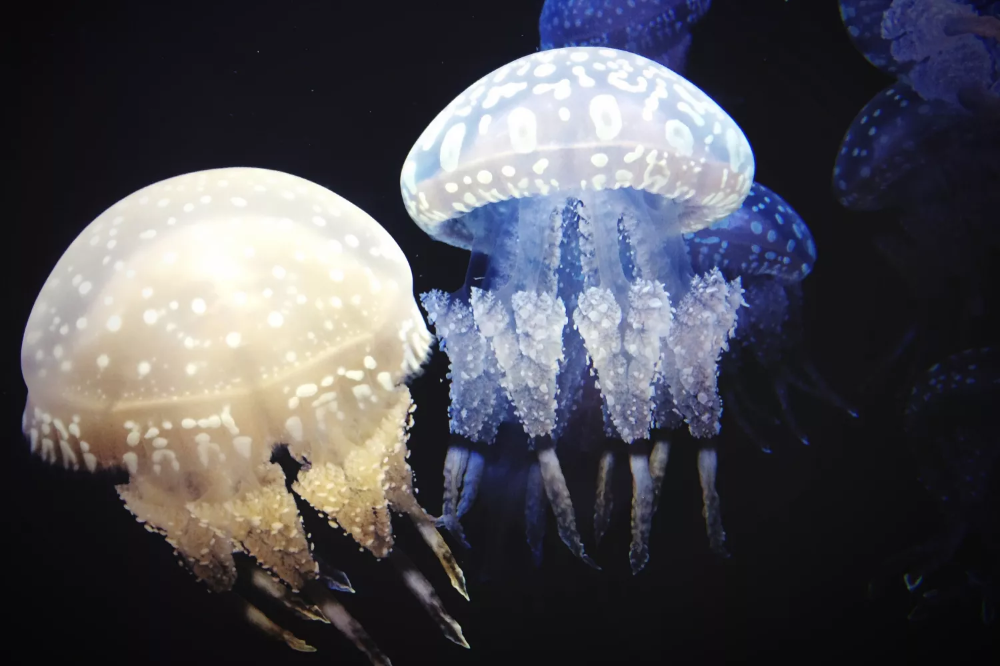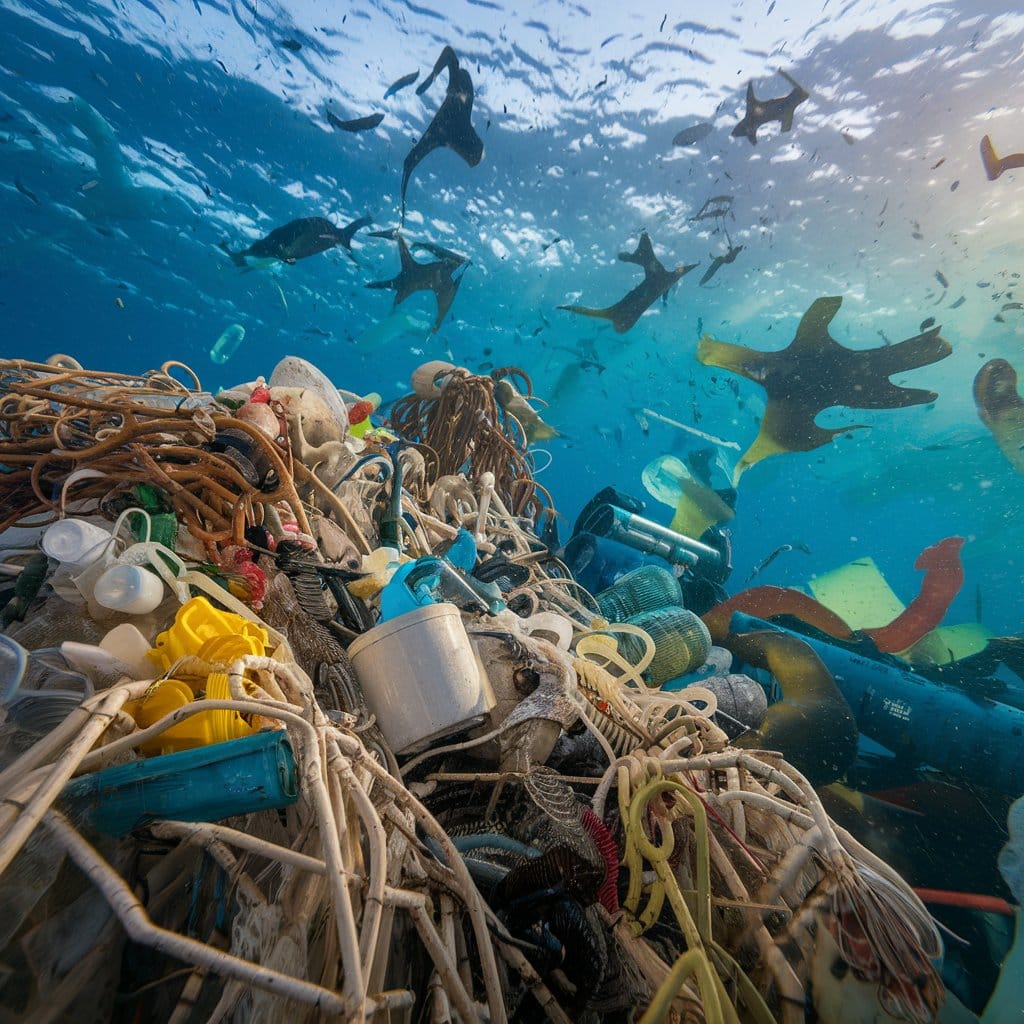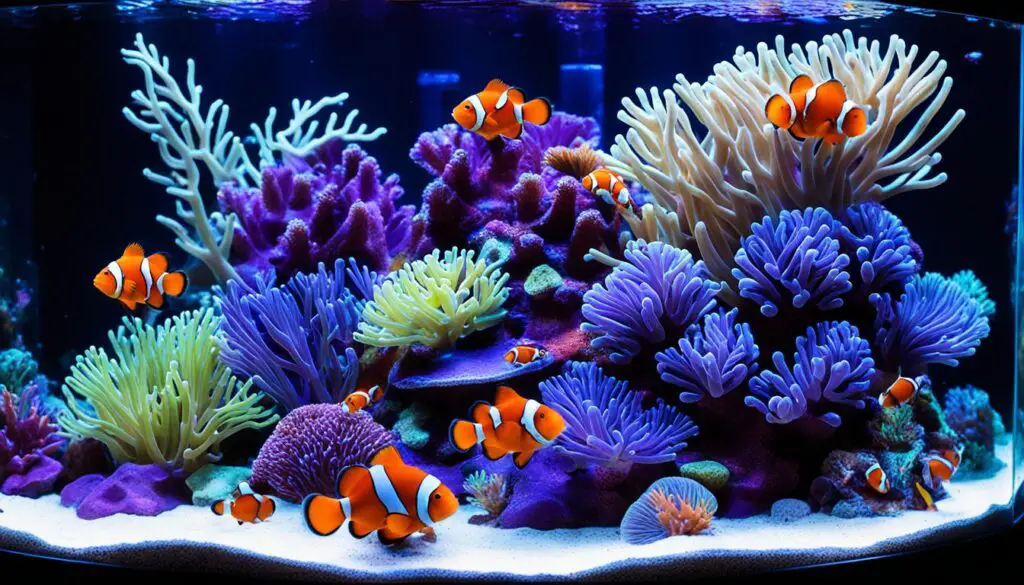How Do Jellyfish Use Bioluminescence

Introduction
How Do Jellyfish Use Bioluminescence: The mysterious world of the ocean conceals countless wonders, and among its most enigmatic inhabitants are jellyfish. These ethereal creatures, known for their gelatinous bodies and graceful, undulating movements, possess a unique and captivating feature: bioluminescence. Bioluminescence is the production and emission of light by living organisms, and jellyfish employ this extraordinary capability in diverse ways to navigate, communicate, hunt, and defend themselves in the dark, watery depths of the world’s oceans.
Bioluminescence in jellyfish is a product of their intricate biology, involving a specialized light-producing chemical reaction within their cells. This remarkable phenomenon has evolved over millions of years, allowing jellyfish to adapt to their deep-sea environment and interact with their surroundings and fellow creatures in distinct ways.
Jellyfish use bioluminescence primarily as a tool for communication. They produce flashes of light in response to various stimuli, such as physical contact, changes in water temperature, or the presence of predators. These displays can serve as warnings to potential threats or as courtship signals to attract mates. In some species, bioluminescent bursts create dazzling visual spectacles, with jellyfish pulsating in unison, illuminating the dark waters in mesmerizing fashion. The intricate patterns and sequences of these displays are still a subject of scientific investigation.

How are jellyfish bioluminescent?
The glow occurs when a substance called luciferin reacts with oxygen. This releases energy, and light is emitted. An enzyme called luciferase facilitates the reaction. Sometimes luciferin and luciferase are bound together with oxygen into a single molecule, or photoprotein.
Jellyfish’s bioluminescence, a captivating and often otherworldly feature, is a result of a complex chemical reaction that occurs within specialized cells called photocytes. These photocytes are primarily found in the jellyfish’s translucent umbrella-shaped body, with some species possessing them in their tentacles as well. The key players in this mesmerizing process are light-producing molecules known as luciferin and an enzyme called luciferase. Luciferin is a substrate that, when combined with oxygen, is oxidized by luciferase, leading to the release of photons, or particles of light. The result is the ethereal glow that defines jellyfish bioluminescence.
Interestingly, the intensity and color of the bioluminescence can vary among different species of jellyfish. This variability is due to the presence of specific proteins and pigments within the photocytes that influence the light’s color and brightness. In some jellyfish, the emitted light appears blue, while in others, it can range from green to yellow.
These differences in coloration can serve various ecological purposes, such as attracting prey, deterring predators, or attracting mates. Additionally, the ability to control the intensity of their bioluminescence allows jellyfish to adapt to their ever-changing environmental conditions, enhancing their survival in the deep, dark expanses of the ocean.
The bioluminescence of jellyfish is a remarkable natural phenomenon that results from a finely tuned chemical reaction within their specialized cells. This remarkable ability to produce light has evolved over millions of years, providing these enigmatic creatures with unique tools for communication, predation, and defense in their deep-sea habitats.
How do moon jellies use bioluminescence?
Bioluminescence: Some species of moon jellyfish are capable of bioluminescence, producing light through a chemical reaction in their bodies. This light is used for a variety of purposes, including attracting mates, deterring predators, and attracting prey.
Moon jellies, scientifically known as Aurelia aurita, are renowned for their graceful and translucent appearance, which, in part, owes to their exquisite use of bioluminescence. Unlike some other bioluminescent creatures, moon jellies don’t use this natural light show for predation or defense. Instead, their bioluminescence primarily serves as a fascinating mechanism for camouflage and perhaps even a means of regulating their daily activities. Moon jellies emit a soft, bluish-green bioluminescent glow from their outer layer, or epidermis, which aids in rendering them nearly invisible in the ambient light of the open ocean. This intricate adaptation allows them to blend harmoniously with their surroundings, making them less conspicuous to both potential predators and prey.
Moon jellies’ use of bioluminescence doesn’t end with camouflage, though. Some studies suggest that they may employ their bioluminescent capabilities to regulate their daily vertical migration patterns. These gentle pulsations between the surface waters at night and deeper waters during the day are integral to their survival. It’s believed that moon jellies may use their bioluminescence as a signal to synchronize these movements. As they ascend to the surface under the cover of darkness, their faint bioluminescent glow may help them maintain a certain depth or distance from the surface, thereby avoiding the harsh sunlight and potential threats from above.
Moon jellies’ use of bioluminescence is a subtle yet intriguing adaptation that reflects their unique place in the intricate tapestry of marine life. Their bioluminescent glow serves the purpose of both camouflaging and potentially regulating their daily migrations, allowing these captivating creatures to navigate the open ocean more effectively. This showcases the remarkable diversity of functions that bioluminescence can serve in the world of marine organisms, adding another layer of wonder to the mysteries of the deep.
How jellyfish use bioluminescence as a form of defense?
Bioluminescence as a Response to Predation
Bioluminescence in jellies serves a primarily defensive function. The bright flash of light is thought to startle predators, causing them to hesitate and allowing the animal a chance to get away.
Jellyfish have evolved a remarkable array of strategies for their survival, and one of the most intriguing is the use of bioluminescence as a form of defense. When threatened by potential predators, many species of jellyfish unleash a brilliant display of light, turning the dark depths of the ocean into a dazzling spectacle. This sudden burst of bioluminescence serves several essential purposes in their defense mechanisms.
First, it momentarily disorients and confuses their attackers, acting as a dazzling distraction that may buy precious seconds for the jellyfish to escape. The bright light can impair the vision of the predator, making it difficult to target the jellyfish with precision. the sudden burst of bioluminescence can attract larger, secondary predators to the scene, diverting the attention of the initial attacker and allowing the jellyfish to make a hasty retreat.
These coordinated tactics of distraction and diversion underscore the ingenious ways in which jellyfish utilize bioluminescence as a powerful tool to survive and thrive in the challenging world of the deep sea. The ethereal beauty of their defensive light show is a testament to the intricacies of marine life and the myriad strategies that have evolved over eons, enabling these enigmatic creatures to navigate the often perilous waters of the ocean.
How does bioluminescence work in crystal jellyfish?
Luminescence. This jellyfish is capable of producing flashes of blue light by a quick release of calcium (Ca2+), which interacts with the photoprotein aequorin. The blue light produced is in turn transduced to green by the now famous green fluorescent protein (GFP).
The mesmerizing bioluminescence of crystal jellyfish, scientifically known as Aequorea victoria, is a stunning natural phenomenon that has captivated researchers and enthusiasts alike. This jellyfish employs a unique system of bioluminescence, driven by a special protein called green fluorescent protein (GFP). Inside the bell-shaped body of the crystal jellyfish are specialized cells, known as photocytes, that contain GFP.
The process begins when the jellyfish absorbs blue or ultraviolet light from its surroundings. This absorbed light energy activates the GFP, causing it to fluoresce and emit green light. Remarkably, this entire process occurs with exceptional efficiency, making GFP one of the most extensively studied and widely utilized proteins in biological research. The green light produced by GFP creates the radiant, ethereal glow that characterizes crystal jellyfish.
The gentle, green luminescence can lure small planktonic organisms towards the jellyfish’s tentacles, where they become ensnared by its stinging cells. Simultaneously, the radiant display of light can deter potential predators by either temporarily blinding them or startling them with the unexpected burst of brightness, providing the jellyfish with a critical moment to escape danger.
The study of crystal jellyfish’s bioluminescence, specifically the GFP, has revolutionized the field of molecular and cellular biology. Scientists have harnessed GFP as a valuable tool, allowing them to trace and monitor cellular processes, gene expression, and protein localization in various organisms, including humans. This discovery showcases the profound impact that understanding nature’s bioluminescent wonders can have on scientific research, revealing the hidden mysteries of life and enabling countless breakthroughs in various scientific disciplines. Crystal jellyfish’s bioluminescence, with its green fluorescent protein, is not only a breathtaking natural spectacle but also a testament to the brilliance of nature and the myriad ways it continues to inspire and inform our quest for knowledge.
How do jellyfish detect light?
Though brainless, jellies have simple tools that allow them to sense the world around them. Jellies detect light, gravity and hormones using rhopalia — small sensory structures — located on the edge of their bells.
Jellyfish possess a fascinating capacity to detect light, and their ability to do so is integral to their survival and behavior in the depths of the ocean. They rely on a simple yet effective network of light-sensitive structures, which are primarily concentrated in and around their umbrella-shaped bells. These structures, known as rhopalia, contain specialized light-sensing cells called ocelli, or eye spots, which are remarkably similar to the photoreceptor cells found in more advanced visual systems.
Jellyfish ocelli can detect both the intensity and direction of light. While they lack the complex eyes of many other animals, these eye spots can sense changes in ambient light levels, helping jellyfish ascertain whether they are ascending towards the surface or descending into darker waters. This basic form of light detection aids in their daily vertical migrations, ensuring they stay within the optimal range of their prey or avoid predators. Additionally, ocelli can discern the direction of light, assisting jellyfish in determining the source of illumination. This is particularly useful when they encounter bioluminescent organisms or when they need to adjust their own bioluminescence for camouflage or defense.
Moreover, jellyfish are sensitive to polarized light, enabling them to perceive patterns and contrasts in the play of sunlight penetrating the ocean’s surface. This ability is crucial for their survival as it helps them locate potential prey, such as zooplankton or small fish, and react to potential threats. While their visual system is far from complex, jellyfish have developed a remarkable set of adaptations that allow them to navigate their environment with a level of sophistication well-suited to their simple yet captivating existence in the mysterious world of the deep sea. In essence, jellyfish’s ability to detect light, despite its seeming simplicity, underscores the intricacies of nature’s solutions to the challenges of life in the ocean’s depths.
What do bioluminescent jellyfish eat?
Plankton
Jellyfish and ctenophores are carnivorous, and will eat just about anything they run into! Most jellies primarily eat plankton, tiny organisms that drift along in the water, although larger ones may also eat crustaceans, fish and even other jellyfish and comb jellies.
Bioluminescent jellyfish, like their non-bioluminescent counterparts, have a diverse diet that primarily consists of small aquatic organisms. These gelatinous creatures are opportunistic feeders, and the specific prey they target can vary among different species. A common staple in the diet of bioluminescent jellyfish is zooplankton, including tiny crustaceans, copepods, and small fish larvae. They use their long, stinging tentacles armed with specialized cells called nematocysts to capture and immobilize their prey.
The stinging cells, upon contact with the prey, inject paralyzing toxins, allowing the jellyfish to then transport the immobilized organisms to their oral arms, which surround the mouth at the center of their bell-shaped bodies. Some bioluminescent jellyfish are known to exhibit a diurnal feeding pattern, while others may be more active during the nighttime hours. Their bioluminescence can be employed both as a lure to attract prey towards their tentacles and as a potential distraction to deter predators while they hunt. In this way, these elegant and radiant creatures utilize their bioluminescence not only for defense but also as a key tool in their hunting strategy, helping them secure the sustenance they need in the dark, mysterious realms of the ocean.
What are bioluminescent jellyfish facts?
Jellyfish can glow in the dark.
Approximately 50% of jellyfish are bioluminescent, meaning they can produce light. The vibrant, colorful hues these animals emit when they glow in the dark aren’t accidental—they use this light to defend against predators and attract prey.
Bioluminescent jellyfish are creatures of captivating mystery, enchanting both scientists and admirers of the natural world. Here are some intriguing facts about these bioluminescent marvels:
Bioluminescent Spectacle: Bioluminescent jellyfish produce their own light, creating mesmerizing displays in the dark depths of the ocean. They do so by utilizing specialized cells, known as photocytes, that contain light-emitting molecules like luciferin and the enzyme luciferase.
Diverse Species: Bioluminescence is not limited to one type of jellyfish; it can be found in various species. The Aequorea victoria, known for its green fluorescent protein, is among the most famous bioluminescent jellyfish, while others display a range of colors, from blue to green.
Camouflage and Defense: Bioluminescence serves a dual role for jellyfish. It can be used as a form of camouflage, allowing them to blend into their environment, making them less visible to potential predators. Conversely, when threatened, they can release intense bursts of light to disorient attackers and attract larger predators to divert their foes’ attention.
Communication Tool: Bioluminescent signals are a vital mode of communication among jellyfish. They use light displays to convey messages like warnings, mating signals, and even coordinate group behaviors, such as synchronized pulsing in certain species.
Deep-Sea Wonders: Bioluminescent jellyfish are commonly found in the darker realms of the ocean, making them a subject of study and fascination in marine biology. Their adaptations to low-light environments, including their light-sensitive ocelli, showcase the remarkable ways in which life thrives in diverse habitats.
Bioluminescence in Research: Beyond their aesthetic appeal, the bioluminescent proteins in jellyfish have significantly contributed to scientific research. Green fluorescent protein (GFP), originally discovered in the Aequorea victoria, has become a vital tool in molecular and cellular biology, aiding in various studies and medical applications.
Global Distribution: Bioluminescent jellyfish are not confined to a single region of the world’s oceans. They can be found in a wide range of marine environments, from shallow coastal waters to the inky depths of the open ocean.
Symbiotic Relationships: Some bioluminescent jellyfish have symbiotic relationships with other organisms. For instance, juvenile fish and small crustaceans may find refuge among their tentacles, benefiting from the jellyfish’s protection while the jellyfish gain mobility for hunting.
Ongoing Discovery: Despite their centuries-old recognition, bioluminescent jellyfish continue to be the subject of ongoing research, revealing more about their behavior, ecology, and the ways they influence the marine ecosystems they inhabit.
Bioluminescent jellyfish offer a stunning glimpse into the intricate and diverse world of marine life. Their radiant displays, multifaceted adaptations, and contributions to scientific understanding make them a source of enduring wonder in the study of the oceans and the natural world.
Do bioluminescent jellyfish sting?
They may look like normal jellyfish, but they don’t sting. Comb jellies in Florida are known for creating colors by emitting a flashing green-blue light whenever kayakers’ hands or paddle disturbs them. They also create a glow by refracting light through the movement of their cilia.
Many bioluminescent jellyfish are equipped with stinging tentacles that can deliver painful stings to humans and other potential threats. These stinging cells, called nematocysts, contain specialized harpoon-like structures that release venom upon contact. When a jellyfish’s tentacles come into contact with an organism, the nematocysts deploy, injecting venom into the victim.
The severity of the sting can vary among different species of jellyfish, with some causing only minor discomfort and others, such as the box jellyfish, delivering venom that can be life-threatening. While bioluminescence is a mesmerizing feature of these creatures, it is essential to exercise caution when encountering them in the wild, as their stings can range from mildly irritating to quite painful, requiring prompt medical attention in severe cases.
It is advisable to be aware of jellyfish species in the area, adhere to safety, and take appropriate precautions when swimming or diving in locations where bioluminescent jellyfish are known to inhabit.

Conclusion
In the depths of the ocean, where darkness reigns and mysteries abound, jellyfish illuminate the hidden world with their exquisite bioluminescence. This remarkable feature not only captures our imaginations but also serves as a testament to the extraordinary ways in which these enigmatic creatures have adapted to their environment. As we conclude our exploration of how jellyfish use bioluminescence, we find that this radiant capability is a multifaceted tool that shapes their lives in profound ways.
First and foremost, bioluminescence light, allows them to communicate in the inky abyss. The pulsating patterns and synchronized displays are not merely aesthetic wonders; they are essential for survival. These displays can convey messages of danger, courtship, and camaraderie in a world where sound and touch are less effective means of communication. The bioluminescent ballet of jellyfish has intrigued scientists and mesmerized observers, but its intricacies are a testament to the richness of life beneath the waves.
Jellyfish also employ bioluminescence as a strategic weapon in their hunt for sustenance. By using their glowing tentacles to attract and ensnare prey, they showcase nature’s genius in adaptation. This captivating method is a stark reminder that even in the darkest corners of the ocean, life has evolved ingenious mechanisms for survival. The glow of the jellyfish not only seduces its quarry but also delivers a paralyzing sting, exemplifying the cunning strategies that have evolved in this ancient lineage of organisms.



